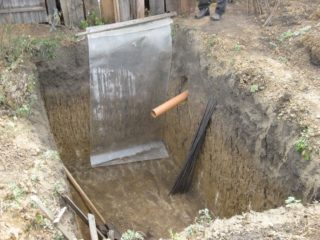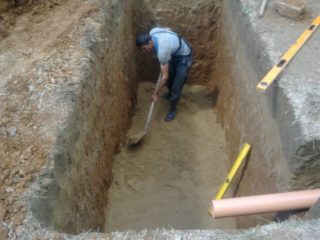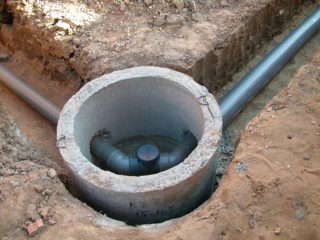Kitchen sink, bathtub, shower cubicle, toilet - all this fully provides comfort for living in a house outside the city, but at the same time requires the organization of reliable and effective treatment and disposal of waste water.
Pit or septic tank
Septic tanks are very simple in structure, as well as non-volatile, moreover, for a family of 4 people, such a sump is quite enough. But at the same time, it is necessary to comply with all sanitary standards: the sump should be located at a distance of one meter and further from groundwater. You can also install a bioremediation device.
And finally, it is necessary to choose the materials from which the cleaning equipment is made. Septic tanks and bio-treatment plants, in the creation of which high-pressure polyethylene, fiberglass or polypropylene were used, are very resistant to biological and chemical influences. The treatment equipment is a ready-made module that does not need to be assembled. You just need to strengthen it well in the ground. Unlike bio-purification systems, septic tanks can be made from both polymers and reinforced concrete. Their cost is lower than plastic ones, but the installation process is much more complicated and takes more time. Such containers serve up to thirty years. The optimal ones are those that were made of B15 concrete or high quality steel.
Installation recommendations
- at least 5 meters from the house itself;
- 5 meters from the road;
- 3 meters from all vegetation;
- 10 meters from a river or stream;
- 30 meters from any other body of water.
To install the container, you need to make a foundation pit. At its bottom, a base is equipped, which is made up of monolithic concrete blocks or a reinforced concrete slab. From above, the installation is covered with a small layer of soil. A hatch is left outside, most often painted green. In septic tanks, it is used for purification after a certain period, and in biological purification systems - for technological maintenance.
You need to know that the installation of a septic tank and treatment system is difficult for a beginner, so it is worth entrusting this work to a professional. And it is worth purchasing equipment from the company that provides installation services and provides technological maintenance. When making a purchase, you need to make sure that there is a sanitary certificate and permission from the sanitary and epidemiological station. If not, then the installation is illegal.
Wiring
Pipes are mounted, starting from the device farther from the riser, along the way connecting the other weir devices to it. The pipe must be located at a distance of at least 2 cm from any building structure. And from the hot water supply and heating systems, the pipe is retracted at a distance of at least 10 cm. As for the sewer pipes, they must be lower than the hot pipeline. During the connection, it is imperative to make a slope of one or two centimeters for each running meter of the pipeline.
Sewer pipes have a large diameter, so they are difficult to hide, and this must be taken into account when planning all systems of the house. It is very good if all bathrooms and bathrooms are located as close as possible to the riser in order to reduce the length of the pipes. In addition to the latter, you will need corners, all kinds of connecting parts and other similar elements. In this case, follow these recommendations: when performing horizontal routing in places where it is necessary to turn the pipeline by 90 degrees, use 2 knee connectors. If you want a right angle, this can only be done when the joints are vertical.











